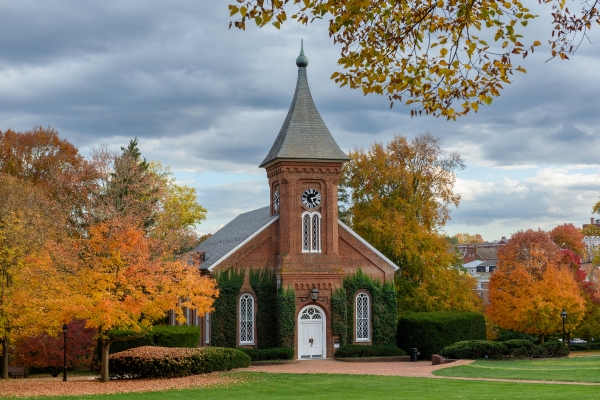Washington and Lee University to Replace Foundation Landscaping Surrounding University Chapel The diverse palette of plant materials includes native plant species focusing on varied colors, sizes and textures to accentuate the beauty of the historic structure.
The landscaping surrounding Washington and Lee University’s historic University Chapel is slated for replacement this week. With a comprehensive plan already in place, the landscaping work is expected to be completed by the Thanksgiving holiday.
The replacement plan, developed in collaboration with the Garden Club of Virginia (GCV), seeks to replace the aging foundation plantings, many of which originate back to renovations performed in the 1950s and again in the 1980s.
“Many of these plants, including the two yews that frame the front of the chapel, have considerable age to them and have become challenging to maintain,” said Tom Kalasky, executive director of university facilities. “In some cases, there are just six to eight inches of green vegetation at the end of woody branches and are beyond being appropriately pruned.”
After university facilities identified a compounding maintenance challenge associated with these foundation plantings, Kalasky approached the GCV to determine its amenability in re-envisioning the landscape around the chapel.
“The GCV’s restoration committee expressed its support and worked with us to develop a comprehensive plan to remove all of the existing plants and replace them with a landscape that anchors the chapel into the site with a balanced design that complements the architecture rather than making its own statement,” he said.
Following the GCV’s recommendation, the university engaged with Nelson Byrd Woltz to serve as landscape architect for the project. The award-winning firm dispatched a cultural landscape historian to devise a landscaping plan that accentuates the chapel’s history and beauty through varied colors, heights and textures. The plan incorporates a variety of native species and includes seasonal flowering and foliage that will change the look depending on the time of year.
“The bloom schedule was designed for the landscaping to provide seasonal interest during significant university events such as matriculation and commencement,” said Kalasky.
A combination of ground cover, shrubs, trees, perennials and bulbs will frame the chapel. All told, 16 types of plant and tree species will adorn the chapel grounds. The building’s iconic ivy vines that cover the façade will remain untouched following a significant pruning in May 2023.
Orrison Tree Service will handle the removal of the current plant material, while J.W. Townsend will serve as the landscaper for the replacement plantings.
 University Chapel. Photo by Ryan Doty ’26
University Chapel. Photo by Ryan Doty ’26
You must be logged in to post a comment.